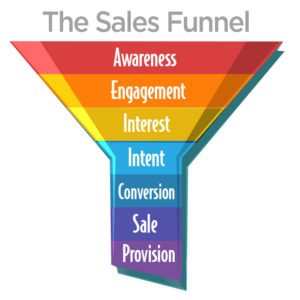By Robyn Sachs, President & CEO, RMR & Associates, Inc.

Many CEOs are constantly searching for that one perfect solution to increase revenue, and in the process, they’re often bombarded with “can’t miss” pitches. They go searching like Diogenes for an honest solution, but they end up becoming increasingly cynical as they realize that most solutions rarely work as promised.
I believe the true solution is rooted in what W. Edwards Deming, noted proponent of quality control, reportedly said: “In God we trust, all others must bring data.” That is easier said than done, as prospects rarely report how they decide …or do they? If CEOs could measure the decision-making process of potential customers and acquired customers, they could gain a better understanding of how they could improve.
The key lies in integrated sales and marketing teams that understand, measure and manage the sales funnel. The sales funnel is a series of distinct steps, often sequential, that lead a prospect to purchase a product or service. “Funnel management” maps the customer’s journey from not knowing anything about the company to spending money on the company’s product or service. The funnel can be the company’s own Diogenes journey — but a successful one.
Companies that have a unified marketing and sales approach that is focused on the prospect’s experience through each stage of the decision-making process will always see more profitability and effectiveness. Understanding the sales funnel and how each department manages the steps increases effectiveness, efficiencies and bottom-line results. 
1. Brand awareness
This is the first step of the funnel. Brand awareness is where a prospect recognizes the brand and, most importantly, the positioning and messaging that drives a value perception. This can be triggered by the logo, a message or an actual product. Every effort to drive positive brand awareness comes from the marketing department: logos, messaging, ads and a strategy for how to attract the targeted customer.
2. Engagement
Now that prospects recognize the brand and its value, they need to begin to interact with it. Common examples of engagement include viewing an ad or searching for the brand online. Consumers might read a story, attend a webinar or listen to a presentation. Engagement usually falls under the marketing department’s responsibility since it determines how to efficiently engage with the audience. This might mean social media spots, ads and improved SEO.
3. Interest
Once prospects have interacted with the brand, or perhaps its product or service, they develop interest because they understand that it’s relevant to their needs and wants. Most likely, they start to research whether the brand or product satisfies their needs by checking out reviews, blog posts and your website. Again, the marketing department works to move the largest audience from engagement to interest with relevant content and information. Often, this means making the company’s website user-friendly and concise to improve the user experience.
4. Intent
Once a prospect has decided that a product is a good fit for their needs, it means they have formed an intent to know more and, in turn, reduce their perception of risk (usually information-driven) before they make a purchase decision. They may search the company’s website, ask questions, look for referrals and perhaps put out an RFP or compare with competitors. Depending on the complexity of the sales process, either the marketing department or the sales team drives this step. Usually, though, this is where the sales team becomes increasingly important to manage the opportunity to complete a sale.
5. Conversion
The prospect then takes direct action, perhaps filling out an online form, calling a representative or initiating contract discussions. Since they have chosen the brand over every other competitor, the sales department has converted the prospect from intent to action. At this point, the sales team is now usually the key interaction point, although web commerce conversion is driven primarily by marketing.
6. Sale
At this point, prospects actually come into the store and make a purchase, add the product to their online shopping cart on the website or meet to finalize an agreement. Again, this is a prospect-initiated action. The sales department is now in control of all funnel activity. Salespeople will either interact face-to-face with the customer, or they might message the customer online to help with the process. Either way, it’s a proactive transaction by the prospect.
7. Provision
An important step that is commonly overlooked, provisioning refers to the measures a sales department takes to ensure that the sale goes smoothly. Common issues might include supplies running out, shipping taking too long, procurement rules that suddenly change or customers becoming unhappy with the product or agreement. A good sales team working through these issues with the prospect leads to a happier prospect and a saved sale.
Truly profitable companies are those that maintain a healthy funnel of opportunities and reduce prospect losses through the funneling process. Understanding the sales funnel, key metrics, what changes the funnel “shape” and how each department is accountable helps improve the chances of the prospect moving from brand awareness to sale.
The key is for your company to develop measurements for each stage and see where the funnel narrows. Some narrowing is expected, especially from awareness to intent. But if companies are losing the majority of prospects at certain steps, they need to take quick and proactive action. Understanding the sales funnel is crucial to increased results through this well-organized and effective business model. We have seen improvements of 80% or more in completed sales with a proactive and data-driven approach.
Good luck on your own Diogenes search, and keep the lamp lit.
